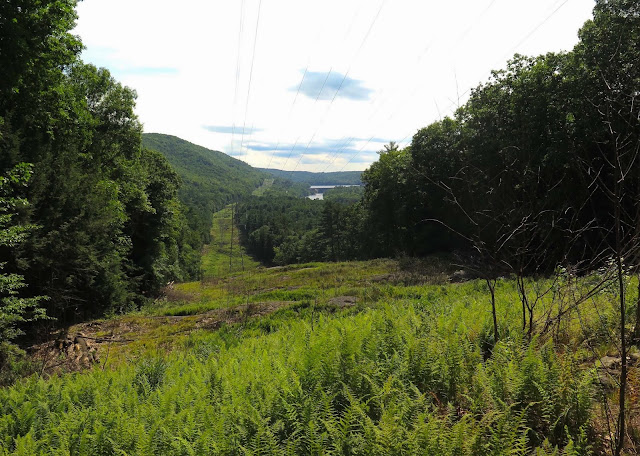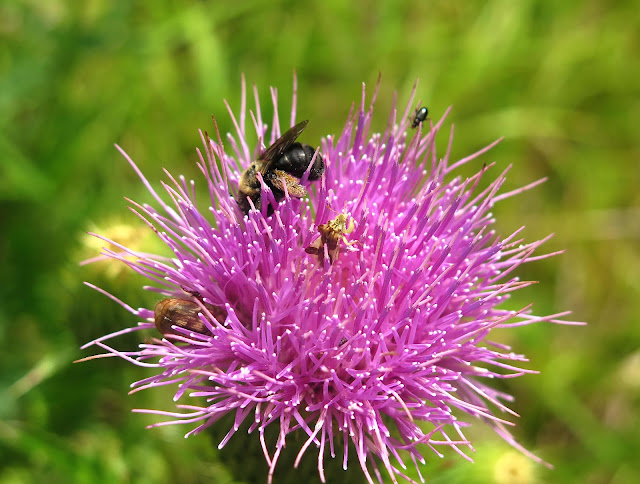Finally! The temps have come down from several days of hovering near 100 degrees! It was bearable once more to come out from under the shade and venture onto an open meadow. I'd been hoping to visit this high grassy area under a mountain-ascending powerline, and now was my chance. I was even able to climb up and up and up and barely break a sweat. And what little bit of sweat dampened my brow was quickly swept away by a nice breeze that blew through the Hudson River valley, channeled by the mountains that rose on either side. From up on this height, I could glimpse a silvery sliver of water held back behind the Spier Falls Dam at Moreau.

A Facebook friend had posted some photos of Pasture Thistle (Cirsium pumilum), so that was my cue to hike up to this mountainside meadow, the only place in all my wanderings I've ever found this gorgeous native wildflower. As thistles go, it's quite short, usually growing no more than knee or thigh high, but with huge rosy blooms almost as big as my fist. The flowers are so large and vivid, they're easy to spot, even among the many other meadow plants that surround them. I found quite a few up here, and all in beautiful fragrant bloom.
And I wasn't the only one who was glad to find these beautiful flowers: every single one was peppered with insects of many different kinds, feasting on the pollen. Most thistle flowers were serving as nuptial beds for mating Long-horned Flower Beetles, but this one had attracted a very busy Bumble Bee, two different species of beetle (one larger, one tiny), and a single Jagged Ambush Bug, doubtless waiting to snag an unwary insect visitor for dinner.
UPDATE: Or could what looks like a Bumble Bee be instead a Long-horned Thistle Bee (Melissodes desponsus), a bee species that feeds only on the pollen and nectar of Field and Pasture Thistles?Here's a more detailed photo of the same bee:
Those rosy-purple thistle blooms certainly set the color scheme for almost all of the other flowers blooming today. I loved how masses of Steeplebush (Spiraea tomentosa) clung to the steep rocky ascent, their colorful flower spikes beautifully profiled against the dark shade of the surrounding forest.
Patches of Wandlike Bush Clover (Lespedeza violacea) reiterated the color theme with clusters of rosy blooms sprouting atop and along their leafy stems.
Panicled Tick Trefoil (Desmodium paniculatum) is the most abundant of the three species of Desmodium I usually find on this mountain meadow. All three species bear similar pea-like flowers colored rosy-purple, but the flowers of D. paniculatum (pictured here) are borne sparsely on open panicles atop weak stems that also bear its distinctively narrow and tapering leaves.
The sprawling ground-hugging vines of Round-leaved Tick Trefoil (Desmodium rotundifolium) hold flowers that tend more toward the purple side of rosy-purple. While the flowers may closely resemble in shape and color those of other Tick Trefoils, there's no mistaking this species' very distinctive big round leaves that lie flat to the ground. Another vernacular name for this plant is Prostrate Tick Trefoil.
(Showy Tick Trefoil, the third Desmodium species I also find at this site, had already finished blooming, so I did not take their picture today. I can attest, however, that their flowers are similar in color to the other two pictured here on this post.)
Wild Marjoram (Origanum vulgare), with dense rounded flower clusters of that same rosy-purple hue, was also blooming abundantly across this high meadow. Because this species (the same as the herb that flavors our pizzas) is not a native wildflower, I had not intended to take a picture of it. But then this gorgeous American Lady Butterfly stopped to sip nectar from its florets. The butterfly didn't care if this was not a native wildflower.

In a week or so, acres of Tall Goldenrod (Solidago altissima) will dominate this high meadow, changing the floral color scheme here from rosy purple to golden yellow. But I was hoping to find some yellow flowers even today as I reached a stretch of bare rocky slopes where I knew a large patch of Orange Grass St. John's Wort (Hypericum gentianoides) would be spread across the thin soil. Well, I found this plant's grass-like stems, all right. And each stem held a tiny, tightly closed yellow flower bud. But I was foiled again, arriving too late in the afternoon to catch the tiny star-shaped flowers that open for only a few hours in the morning.
Since literally thousands of Orange Grass plants were thriving here, I took the liberty of plucking a single one. I intended to place the plant in a tiny vase of water, so that I might catch it in bloom the following morning. And so I did. And so IT did! Ta da! Behold: the tiny, star-shaped yellow flowers of Orange Grass St. John's Wort!












4 comments:
Thank you for this well narrated Intimate tour of some more obscure (to me) and colorful blooms! Such a gift!
Beautiful thistle I'm not familiar with.
I've never paid much attention to thistles --looks like that been an ongoing mistake.
Thanks for your wonderful posts. We just returned from the Saratoga/Skidmore area and you're helping me ID some of my flower pictures as well as educate me on things botanical.
Post a Comment